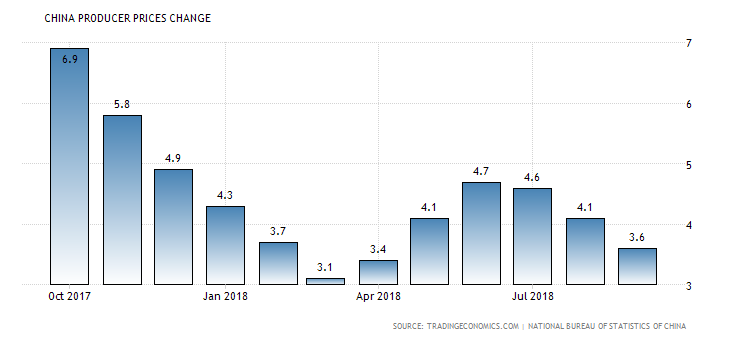China's latest consumer price index data measuring inflation showed a steady print in inflation. Official data released last week showed consumer prices rising 2.5% on the year in September 2018.
This was 0.7% higher on a monthly basis from August.
Producer price index which measures inflation at the factory gate, however, slowed for a third consecutive month sparking speculation that the economic momentum in the world's second-largest economy might be cooling amid rising trade tensions with the United States.
China's inflation is closely watched especially in the backdrop of the rising trade tensions. It is expected that the trade wars would prove to be costly for China which still relies on its exports.
The producer prices index is one indicator that is also closely observed. Official data showed that producer prices for September rose just 3.6% on the year ending September 2018. This was weaker compared to the August's PPI reading of 4.1%. Economists polled expected the PPI to rise at a slower pace of 3.5%. On a month over month basis, producer prices increased 0.6% from August.

Meanwhile, consumer prices index which measures the price of goods and services matched the median forecasts. China's consumer prices are in line with the 3% inflation target set by policymakers for this year.
Consumer prices were driven by an increase in food prices. This came due to the adverse weather conditions and also the Golden week festive season, official data showed.
The markets were muted to the slower PPI data. China has also levied higher tariffs against U.S. goods imported into the country. Beijing administration, in response to the trade tariffs from the U.S., hit a few of the products imported from the United States. However, the impact of this is expected to be limited for the moment.
The higher tariffs on imported goods from the United States are however expected to have an inflationary impact. However, with China's excess capacity, it is expected to remain modest. For consumer prices, this effect is expected to be even more limited. Still, concerns remain that trade tariffs would hit the economic momentum.
Higher tariffs for exports to the U.S. means that China's businesses could see slower growth of orders. In anticipation of the trade wars and its impact, the PBoC, China's central bank is expected to adjust monetary policy to offset the slowdown in growth.
China’s PBoC cuts reserve requirements ratio for a fourth time this year
The Beijing administration is targeting a growth rate of 6.5% for 2018. A week ago, the PBoC governor, Yi Gang commented that he saw plenty of room to adjust interest rates. The central bank has been currently adjusting its reserve requirements ratio or RRR in order to maintain liquidity.

The central bank said that this was needed due to the downside risks emanating from the trade wars.
The PBoC had cut the RRR or the number of reserves that banks need to hold at the central bank for the fourth time.
Effective Monday, 15th October, the PBoC lowered the reserve requirements by one percentage point. As a result, the liquidity that came out of this move was said to be around 65 billion U.S. dollars. This was used to pay the medium term lending facility that was maturing on Monday.
The remainder of the amount was said to be used to inject liquidity into the market.
The PBoC had previously lowered the reserve requirements in January, April, and June this year. On a year to date basis, China cut the reserve requirements by 2.5% for banks.
China's reserve requirements currently at 14.5% following the cut on October 15, 2018, for large commercial lenders and is it 12.5% for smaller banks.
